Prescott City Council: Analyzing Price Ceilings on Rental Housing
VerifiedAdded on 2023/06/09
|7
|1285
|185
Homework Assignment
AI Summary
This assignment examines the impact of a price ceiling imposed by the Prescott City Council on rental units, utilizing supply and demand analysis. It begins by establishing the equilibrium price and quantity in the rental market before the intervention. The analysis then demonstrates how the price ceil...
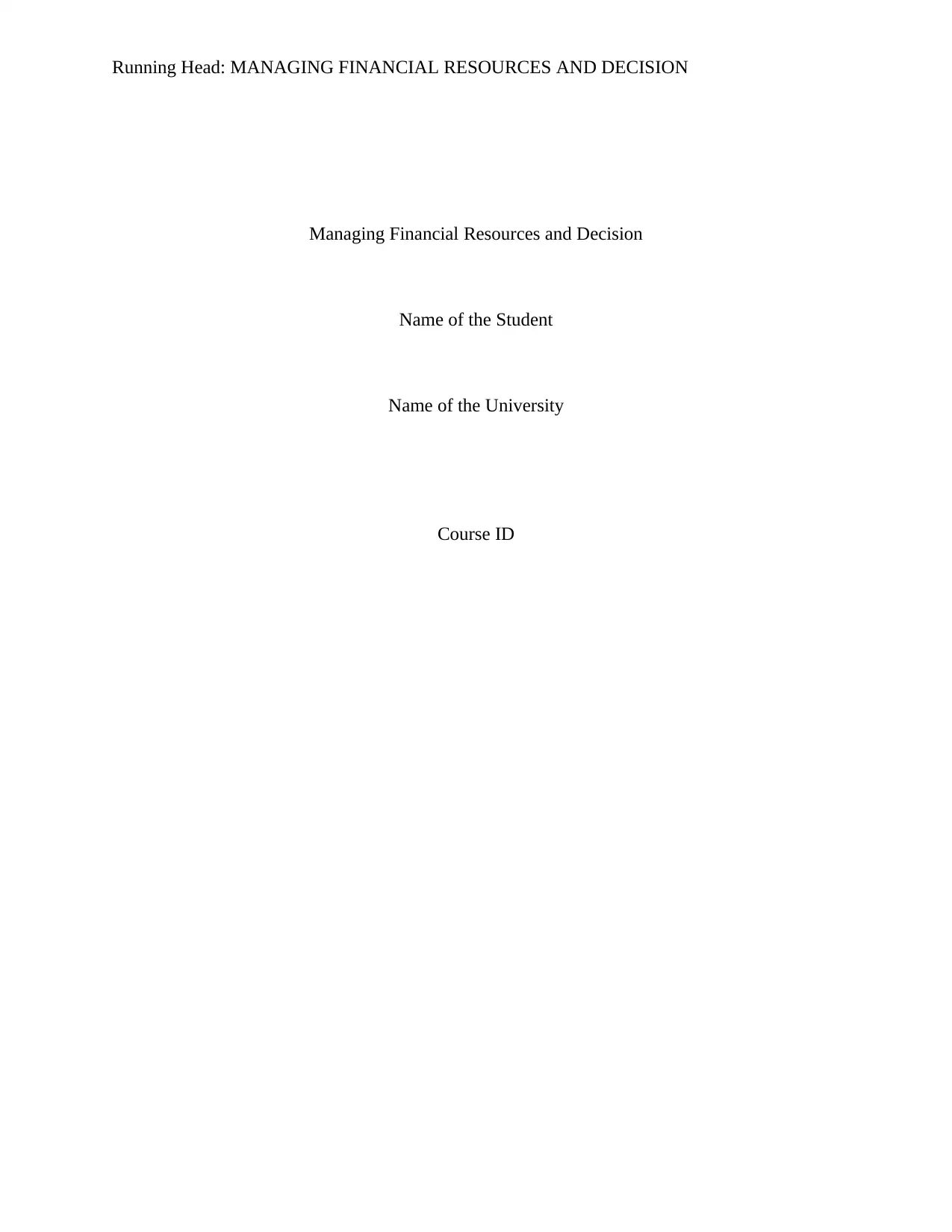
Running Head: MANAGING FINANCIAL RESOURCES AND DECISION
Managing Financial Resources and Decision
Name of the Student
Name of the University
Course ID
Managing Financial Resources and Decision
Name of the Student
Name of the University
Course ID
Paraphrase This Document
Need a fresh take? Get an instant paraphrase of this document with our AI Paraphraser
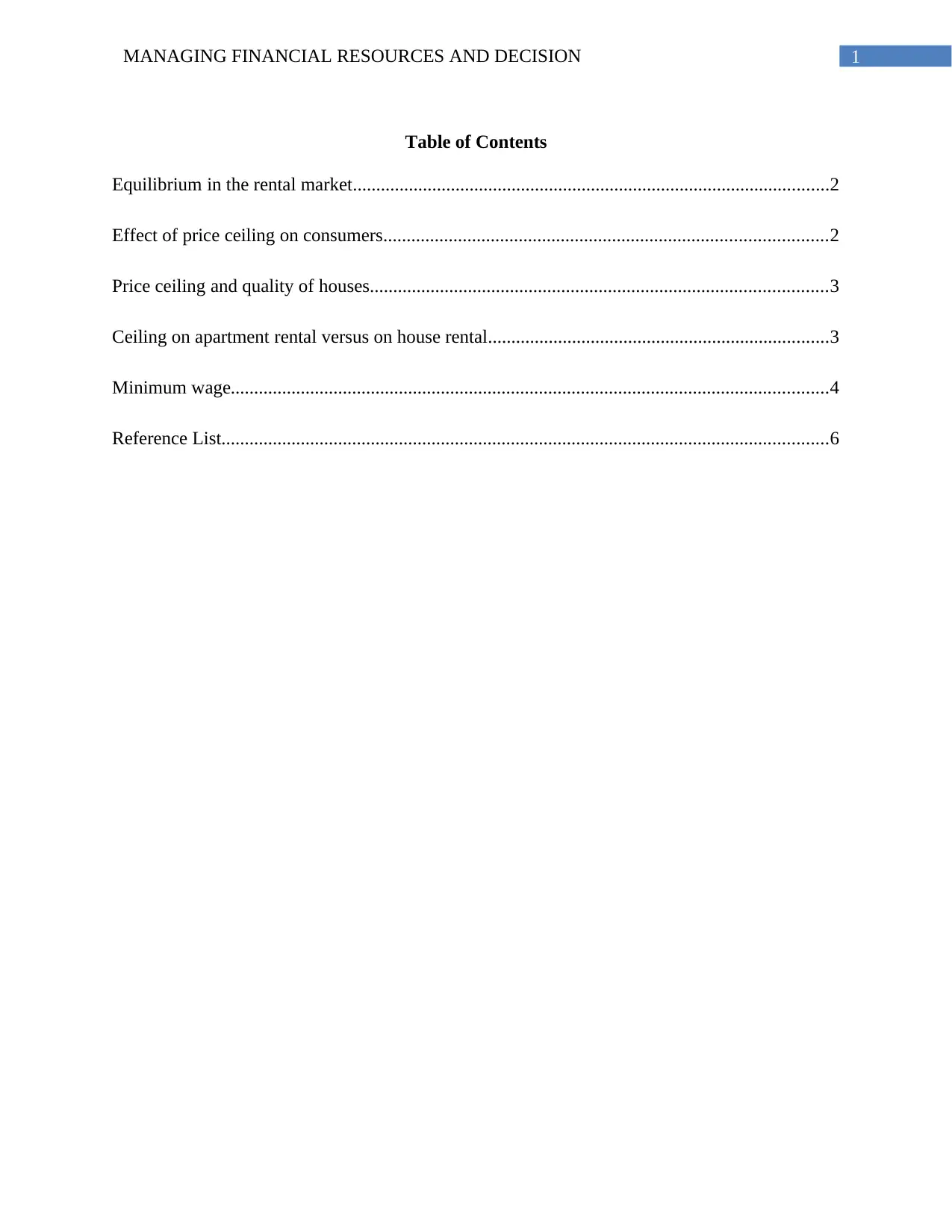
1MANAGING FINANCIAL RESOURCES AND DECISION
Table of Contents
Equilibrium in the rental market......................................................................................................2
Effect of price ceiling on consumers...............................................................................................2
Price ceiling and quality of houses..................................................................................................3
Ceiling on apartment rental versus on house rental.........................................................................3
Minimum wage................................................................................................................................4
Reference List..................................................................................................................................6
Table of Contents
Equilibrium in the rental market......................................................................................................2
Effect of price ceiling on consumers...............................................................................................2
Price ceiling and quality of houses..................................................................................................3
Ceiling on apartment rental versus on house rental.........................................................................3
Minimum wage................................................................................................................................4
Reference List..................................................................................................................................6
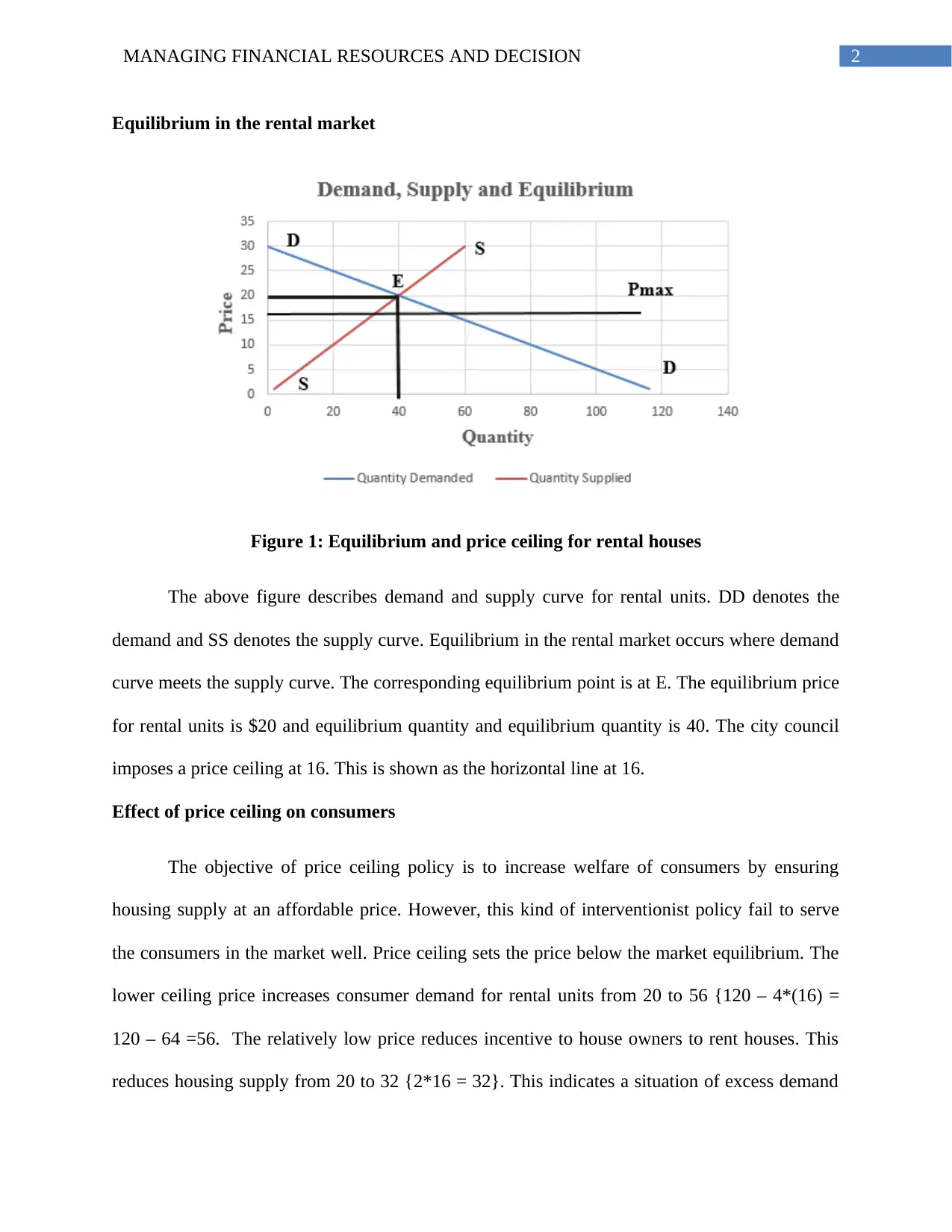
2MANAGING FINANCIAL RESOURCES AND DECISION
Equilibrium in the rental market
Figure 1: Equilibrium and price ceiling for rental houses
The above figure describes demand and supply curve for rental units. DD denotes the
demand and SS denotes the supply curve. Equilibrium in the rental market occurs where demand
curve meets the supply curve. The corresponding equilibrium point is at E. The equilibrium price
for rental units is $20 and equilibrium quantity and equilibrium quantity is 40. The city council
imposes a price ceiling at 16. This is shown as the horizontal line at 16.
Effect of price ceiling on consumers
The objective of price ceiling policy is to increase welfare of consumers by ensuring
housing supply at an affordable price. However, this kind of interventionist policy fail to serve
the consumers in the market well. Price ceiling sets the price below the market equilibrium. The
lower ceiling price increases consumer demand for rental units from 20 to 56 {120 – 4*(16) =
120 – 64 =56. The relatively low price reduces incentive to house owners to rent houses. This
reduces housing supply from 20 to 32 {2*16 = 32}. This indicates a situation of excess demand
Equilibrium in the rental market
Figure 1: Equilibrium and price ceiling for rental houses
The above figure describes demand and supply curve for rental units. DD denotes the
demand and SS denotes the supply curve. Equilibrium in the rental market occurs where demand
curve meets the supply curve. The corresponding equilibrium point is at E. The equilibrium price
for rental units is $20 and equilibrium quantity and equilibrium quantity is 40. The city council
imposes a price ceiling at 16. This is shown as the horizontal line at 16.
Effect of price ceiling on consumers
The objective of price ceiling policy is to increase welfare of consumers by ensuring
housing supply at an affordable price. However, this kind of interventionist policy fail to serve
the consumers in the market well. Price ceiling sets the price below the market equilibrium. The
lower ceiling price increases consumer demand for rental units from 20 to 56 {120 – 4*(16) =
120 – 64 =56. The relatively low price reduces incentive to house owners to rent houses. This
reduces housing supply from 20 to 32 {2*16 = 32}. This indicates a situation of excess demand
⊘ This is a preview!⊘
Do you want full access?
Subscribe today to unlock all pages.

Trusted by 1+ million students worldwide
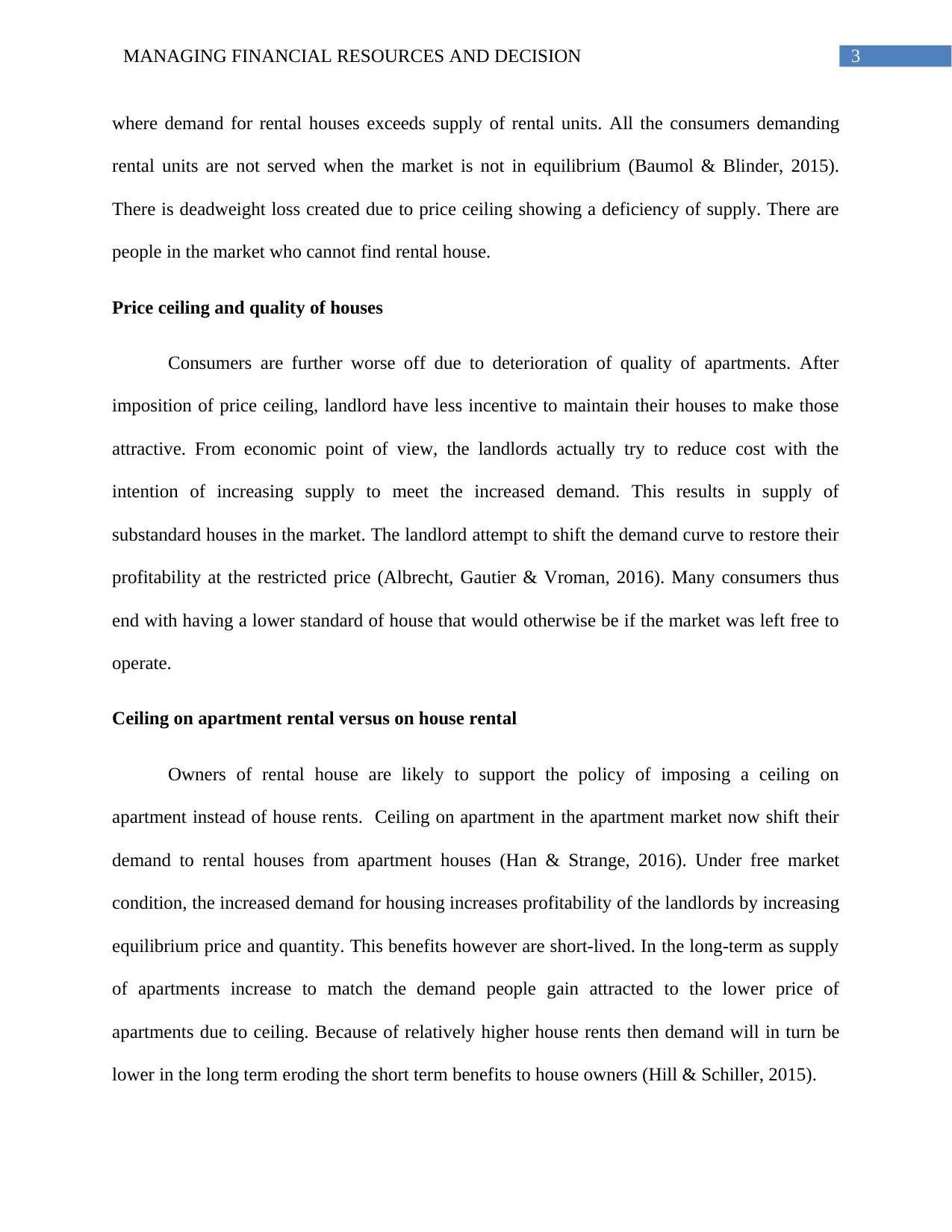
3MANAGING FINANCIAL RESOURCES AND DECISION
where demand for rental houses exceeds supply of rental units. All the consumers demanding
rental units are not served when the market is not in equilibrium (Baumol & Blinder, 2015).
There is deadweight loss created due to price ceiling showing a deficiency of supply. There are
people in the market who cannot find rental house.
Price ceiling and quality of houses
Consumers are further worse off due to deterioration of quality of apartments. After
imposition of price ceiling, landlord have less incentive to maintain their houses to make those
attractive. From economic point of view, the landlords actually try to reduce cost with the
intention of increasing supply to meet the increased demand. This results in supply of
substandard houses in the market. The landlord attempt to shift the demand curve to restore their
profitability at the restricted price (Albrecht, Gautier & Vroman, 2016). Many consumers thus
end with having a lower standard of house that would otherwise be if the market was left free to
operate.
Ceiling on apartment rental versus on house rental
Owners of rental house are likely to support the policy of imposing a ceiling on
apartment instead of house rents. Ceiling on apartment in the apartment market now shift their
demand to rental houses from apartment houses (Han & Strange, 2016). Under free market
condition, the increased demand for housing increases profitability of the landlords by increasing
equilibrium price and quantity. This benefits however are short-lived. In the long-term as supply
of apartments increase to match the demand people gain attracted to the lower price of
apartments due to ceiling. Because of relatively higher house rents then demand will in turn be
lower in the long term eroding the short term benefits to house owners (Hill & Schiller, 2015).
where demand for rental houses exceeds supply of rental units. All the consumers demanding
rental units are not served when the market is not in equilibrium (Baumol & Blinder, 2015).
There is deadweight loss created due to price ceiling showing a deficiency of supply. There are
people in the market who cannot find rental house.
Price ceiling and quality of houses
Consumers are further worse off due to deterioration of quality of apartments. After
imposition of price ceiling, landlord have less incentive to maintain their houses to make those
attractive. From economic point of view, the landlords actually try to reduce cost with the
intention of increasing supply to meet the increased demand. This results in supply of
substandard houses in the market. The landlord attempt to shift the demand curve to restore their
profitability at the restricted price (Albrecht, Gautier & Vroman, 2016). Many consumers thus
end with having a lower standard of house that would otherwise be if the market was left free to
operate.
Ceiling on apartment rental versus on house rental
Owners of rental house are likely to support the policy of imposing a ceiling on
apartment instead of house rents. Ceiling on apartment in the apartment market now shift their
demand to rental houses from apartment houses (Han & Strange, 2016). Under free market
condition, the increased demand for housing increases profitability of the landlords by increasing
equilibrium price and quantity. This benefits however are short-lived. In the long-term as supply
of apartments increase to match the demand people gain attracted to the lower price of
apartments due to ceiling. Because of relatively higher house rents then demand will in turn be
lower in the long term eroding the short term benefits to house owners (Hill & Schiller, 2015).
Paraphrase This Document
Need a fresh take? Get an instant paraphrase of this document with our AI Paraphraser

4MANAGING FINANCIAL RESOURCES AND DECISION
Minimum wage
According to some studies, it can be seen that an economy can receive positive impacts
by increasing minimum wage in labor market, as it can help those people to enjoy higher level of
standard of living. To increase health condition of laborers, it is essential to increase the
minimum wage to $ 15, as it can reduce the premature mortality in the U.S.A. In this context,
Tsao, et al., (2016) have estimated about the impact of increasing minimum wage on the
premature mortality of the people in New York. During 2008 and 2012, New York has
experienced 4% to 8% of total premature deaths. However, this could be reduced by increasing
the minimum wage to $15 per hour. To understand the impact, researchers conducted a survey
from where they have found that minimum wage increase could have prevented almost 2800 to
5500 premature deaths within this period. Thus, they have suggested that higher income can
develop health condition of laborers. Moreover, health disparity can be reduced by increasing
minimum wage. Thus, from this research, it can be said that wage and health condition of a labor
has positive relationship. This means, increase in wage can develop the health conditions of
workers and vice versa.
However, the labor market can experience some negative impacts after increasing the
minimum wages in the U.S. Meer and West have intended to analyze the impact of wage
flooring on employees, as it has remained one of the debatable topics in labor economics.
According to Neoclassical economists, increase in labor wage can reduce the demand for
employees in market. However, some recent findings have pointed that demand for low-wage
labor is inelastic, which means, an increase in wage can adjust employment by slower rate. The
entire discussion has been conducted with the help of three data, which are, the Quarterly
Minimum wage
According to some studies, it can be seen that an economy can receive positive impacts
by increasing minimum wage in labor market, as it can help those people to enjoy higher level of
standard of living. To increase health condition of laborers, it is essential to increase the
minimum wage to $ 15, as it can reduce the premature mortality in the U.S.A. In this context,
Tsao, et al., (2016) have estimated about the impact of increasing minimum wage on the
premature mortality of the people in New York. During 2008 and 2012, New York has
experienced 4% to 8% of total premature deaths. However, this could be reduced by increasing
the minimum wage to $15 per hour. To understand the impact, researchers conducted a survey
from where they have found that minimum wage increase could have prevented almost 2800 to
5500 premature deaths within this period. Thus, they have suggested that higher income can
develop health condition of laborers. Moreover, health disparity can be reduced by increasing
minimum wage. Thus, from this research, it can be said that wage and health condition of a labor
has positive relationship. This means, increase in wage can develop the health conditions of
workers and vice versa.
However, the labor market can experience some negative impacts after increasing the
minimum wages in the U.S. Meer and West have intended to analyze the impact of wage
flooring on employees, as it has remained one of the debatable topics in labor economics.
According to Neoclassical economists, increase in labor wage can reduce the demand for
employees in market. However, some recent findings have pointed that demand for low-wage
labor is inelastic, which means, an increase in wage can adjust employment by slower rate. The
entire discussion has been conducted with the help of three data, which are, the Quarterly

5MANAGING FINANCIAL RESOURCES AND DECISION
Workforce Indicators (QWI), the Business Dynamics Statistics (BDS), collected from the Bureau
of Census and the Quarterly Census of Employment and Wages (QCEW), collected from the
Bureau of Labor Statistics. The outcome represents a negative relationship between job growth
and minimum wage over a long period. This phenomenon can be seen among industries, where
low-wage workers can be found by higher proportion in U.S.A (Meer & West 2015).
Workforce Indicators (QWI), the Business Dynamics Statistics (BDS), collected from the Bureau
of Census and the Quarterly Census of Employment and Wages (QCEW), collected from the
Bureau of Labor Statistics. The outcome represents a negative relationship between job growth
and minimum wage over a long period. This phenomenon can be seen among industries, where
low-wage workers can be found by higher proportion in U.S.A (Meer & West 2015).
⊘ This is a preview!⊘
Do you want full access?
Subscribe today to unlock all pages.

Trusted by 1+ million students worldwide
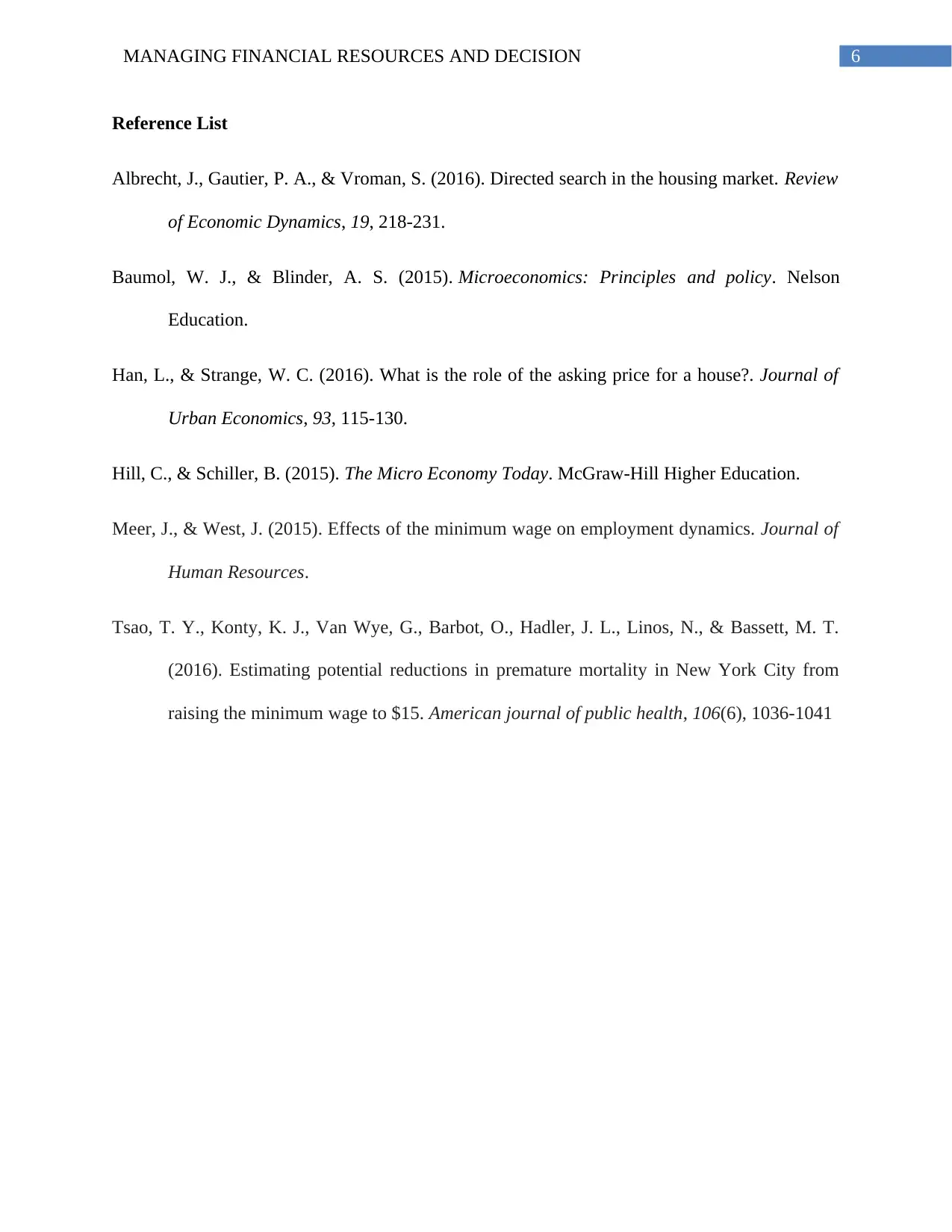
6MANAGING FINANCIAL RESOURCES AND DECISION
Reference List
Albrecht, J., Gautier, P. A., & Vroman, S. (2016). Directed search in the housing market. Review
of Economic Dynamics, 19, 218-231.
Baumol, W. J., & Blinder, A. S. (2015). Microeconomics: Principles and policy. Nelson
Education.
Han, L., & Strange, W. C. (2016). What is the role of the asking price for a house?. Journal of
Urban Economics, 93, 115-130.
Hill, C., & Schiller, B. (2015). The Micro Economy Today. McGraw-Hill Higher Education.
Meer, J., & West, J. (2015). Effects of the minimum wage on employment dynamics. Journal of
Human Resources.
Tsao, T. Y., Konty, K. J., Van Wye, G., Barbot, O., Hadler, J. L., Linos, N., & Bassett, M. T.
(2016). Estimating potential reductions in premature mortality in New York City from
raising the minimum wage to $15. American journal of public health, 106(6), 1036-1041
Reference List
Albrecht, J., Gautier, P. A., & Vroman, S. (2016). Directed search in the housing market. Review
of Economic Dynamics, 19, 218-231.
Baumol, W. J., & Blinder, A. S. (2015). Microeconomics: Principles and policy. Nelson
Education.
Han, L., & Strange, W. C. (2016). What is the role of the asking price for a house?. Journal of
Urban Economics, 93, 115-130.
Hill, C., & Schiller, B. (2015). The Micro Economy Today. McGraw-Hill Higher Education.
Meer, J., & West, J. (2015). Effects of the minimum wage on employment dynamics. Journal of
Human Resources.
Tsao, T. Y., Konty, K. J., Van Wye, G., Barbot, O., Hadler, J. L., Linos, N., & Bassett, M. T.
(2016). Estimating potential reductions in premature mortality in New York City from
raising the minimum wage to $15. American journal of public health, 106(6), 1036-1041
1 out of 7
Related Documents
Your All-in-One AI-Powered Toolkit for Academic Success.
+13062052269
info@desklib.com
Available 24*7 on WhatsApp / Email
![[object Object]](/_next/static/media/star-bottom.7253800d.svg)
Unlock your academic potential
© 2024 | Zucol Services PVT LTD | All rights reserved.





